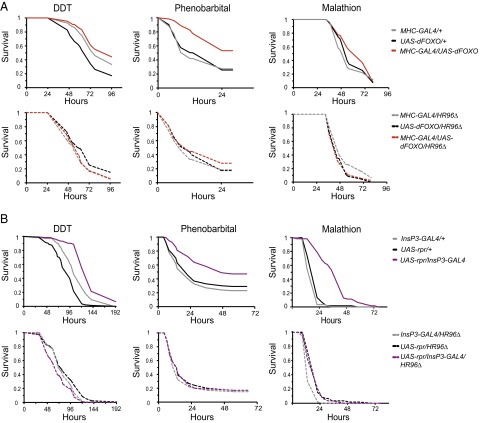Fig. 4.
Analysis of the effects of DHR96 on the xenobiotic resistance of two IIS mutants. (A) Muscle-specific overexpression of dFOXO significantly enhanced resistance to DDT, phenobarbital, and malathion compared with control lines (Upper, log-rank test, P values for all comparisons with the matching driver and UAS lines <0.001, except for comparison of DDT resistance of dFOXO overexpressors with the MHC-GAL4 line, P = 0.61). Enhanced resistance was lost, when dFOXO was overexpressed in a DHR96 null background (Lower; P values for all comparisons with the matching driver and UAS lines >0.05). Cox proportional hazards (CPH) was used to test for a statistical interaction between the effects of dFOXO overexpression and genomic deletion of DHR96, and revealed that each significantly affected stress resistance, with a significant interaction between them (P < 0.01; Table S2). (B) Deletion of the mNSC cells significantly enhanced resistance to the three xenobiotics (Upper, log-rank test, P values for all comparisons with the matching driver and UAS lines <0.001), and this resistance was lost in a DHR96 null background (P values for all comparisons with the matching driver and UAS lines >0.05). CPH analysis revealed a significant interaction between the effect of mNSC ablation and genomic DHR96 deletion, indicating that xenobiotic resistance was significantly blocked by the genomic deletion of DHR96 (CPH, P < 0.001; Table S2).

